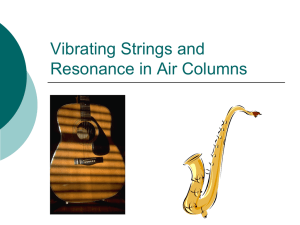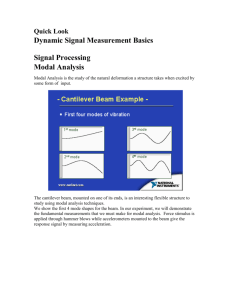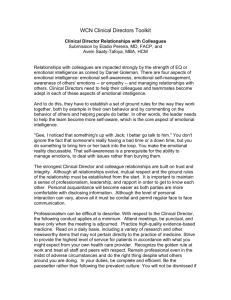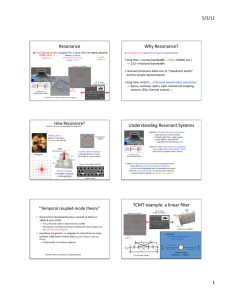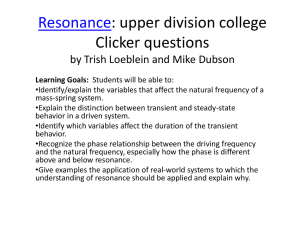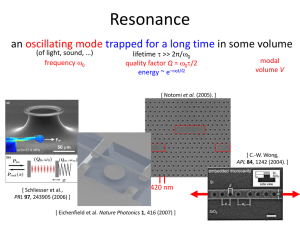Dynamic response - LSU Hurricane Engineering
advertisement
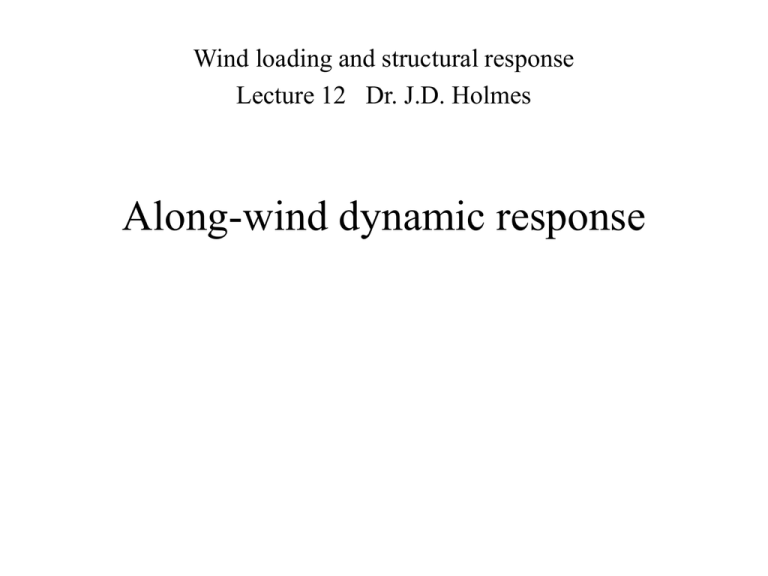
Wind loading and structural response Lecture 12 Dr. J.D. Holmes Along-wind dynamic response Dynamic response • Significant resonant dynamic response can occur under wind actions for structures with n1 < 1 Hertz (approximate) • All structures will experience fluctuating loads below resonant frequencies (background response) • Significant resonant response may not occur if damping is high enough • e.g. electrical transmission lines - ‘pendulum’ modes - high aerodynamic damping Dynamic response • Spectral density of a response to wind : background component resonant contributions Dynamic response • Time history of fluctuating wind force D(t) time Dynamic response • Time history of fluctuating wind force D(t) time • Time history of response : x(t) High n1 time • Structure with high natural frequency Dynamic response • Time history of fluctuating wind force D(t) time • Time history of response : x(t) Low n1 time • Structure with low natural frequency Dynamic response • Features of resonant dynamic response : • Time-history effect : when vibrations build up structure response at any given time depends on history of loading • Additional forces resist loading : inertial forces, damping forces • Stable vibration amplitudes : damping forces = applied loads inertial forces (mass acceleration) balance elastic forces in structure effective static loads : ( 1 times) inertial forces Dynamic response • Comparison with dynamic response to earthquakes : • Earthquakes are shorter duration than most wind storms • Dominant frequencies of excitation in earthquakes are 10-50 times higher than wind loading • Earthquake forces appear as fully-correlated equivalent lateral forces wind forces (along-wind and cross wind) are partially-correlated fluctuating forces Dynamic response • Comparison with dynamic response to earthquakes : Dynamic response • Random vibration approach : • Uses spectral densities (frequency domain) for calculation : Dynamic response • Along-wind response of single-degree-of freedom structure : • mass-spring-damper system, mass small w.r.t. length scale of turbulence representative of large mass supported by a low-mass column c D(t) m k n1 • equation of motion : 1 k 2π m η c 2 mk mx cx kx D(t) Dynamic response • Along-wind response of single-degree-of freedom structure : • by quasi-steady assumption (Lecture 9) : D' C Do 2 2 4D 2 2 ρ a U u' A CD ρ a U u' A 2 u' U 2 2 2 2 2 2 2 since : • in terms of spectral density : • hence : 4D 2 SD (n) 2 Su (n ) U 2 2 CD D 1 ρ a U 02 A 2 4D 2 0 SD (n).dn U 2 0 Su (n).dn this is relation between spectral density of force and velocity Dynamic response • Along-wind response of single-degree-of freedom structure : • deflection : X(t) = X + x'(t) mean deflection : X D k k = spring stiffness spectral density : Sx (n) 1 2 H(n) SD (n) k2 H(n) 2 where the mechanical admittance is given by : 2 1 2 4D Sx (n) 2 H(n) Su (n) 2 k U 1 2 2 n 2 n 1 4η2 n1 n1 this is relation between spectral density of deflection and approach velocity Dynamic response • Aerodynamic admittance: • Larger structures - velocity fluctuations approaching windward face cannot be assumed to be uniform then : 4D 2 SD (n) Χ (n). 2 Su (n ) U 2 where 2(n) is the ‘aerodynamic admittance’ Dynamic response • Aerodynamic admittance: Low frequency gusts well correlated 1.0 χ n 0.1 High frequency gusts poorly correlated 0.01 0.01 0.1 1.0 10 A U n based on experiments : χ n 1 2n A 1 U 4 3 Dynamic response • Aerodynamic admittance: hence : 2 1 2 4D 2 Sx (n) 2 H(n) . Χ (n).S u (n) 2 k U substituting D = kX : 4X 2 2 Sx (n) 2 H(n) . Χ 2 (n).S u (n) U Dynamic response • Mean square deflection : σx σx 2 4X 2 2 Sx (n).dn 2 H(n) . Χ 2 (n).S u (n).dn U 0 0 4X 2σ u U2 where : 2 2 2 Su (n) 4X 2 σ u 2 0 H(n) .Χ (n). σ u 2 .dn U 2 B R 2 S (n) B Χ (n). u 2 .dn σu 0 2 independent of frequency S (n ) 2 R Χ (n1 ). u 21 H(n) .dn σu 0 2 assumes X2(n) and Su(n) are constant at X2(n1) and Su(n1), near the resonant peak Dynamic response • Mean square deflection : H(n) .dn 2 0 πn1 4η πn1Su (n1 ) R Χ (n1 ). 2 4σ u η 2 (integration by method of poles) Dynamic response • Gust response factor (G) : Expected maximum response in defined time period / mean response in same time period X̂ X gσ x G σ X̂ σ 1 g x 1 2g u X X U BR g = peak factor g 2 log e ( υT) 0.577 2 log e ( υT) = ‘cycling’ rate (average frequency) Dynamic response • Dynamic response factor (Cdyn): This is a factor defined as follows : Maximum response including correlation and resonant effects / maximum response excluding correlation and resonant effects B = 1 (reduction due to correlation ignored) R = 0 (resonant effects ignored) Cdyn 1 2g σu U 1 2g BR σu U Used in codes and standards based on peak gust (e.g. ASCE-7) Dynamic response • Gust effect factor (ASCE-7) : For flexible and dynamically sensitive structures (Section 6.5.8.2) 1 1.7I g 2Q 2 g 2 R z Q R G f 0.925 1 1.7g v I z This is a ‘dynamic response factor’ not a ‘gust response factor’ 0.925(instead of 1) is ‘calibration factor’ 1.7 (instead of 2) to adjust for 3-second gust instead of true peak gust Separate peak factors (gQ and gR) for background and resonant response : gQ = gv= 3.4 g R 2 log e (3600n1 ) 0.577 2 log e (3600n1 ) Dynamic response • Gust effect factor (ASCE-7) : Resonant response factor (Equation 6-8) : R Previously : 1 R n R h R B (0.53 0.47R L ) β πn1Su (n1 ) R Χ (n1 ). 2 4σ u η 2 is critical damping ratio () RhRB(0.53 + 0.47RL) is the aerodynamic admittance 2(n1) decomposed into components for vertical separations (Rh), lateral separations (RB) and along-wind (windward/ leeward wall) (RL) Dynamic response • Gust effect factor (ASCE-7) : Rn should be : In fact it is : where : πn1Su (n1 ) 2 4σ u 2 2 πn1Su (n 1 ) . 2 4σ u 1.7 n1Su (n1 ) 6.9 N1 2 1 10.3N1 5 / 3 σu Note that : 6.9=(2/3)10.3 so that 0 N1 n 1L z Vz Su (n) dn 1 2 σu Note that Su(0) is equal to 6.9u2Lz/Vz But Su(0) should = 4u2lu /Uz (Lecture 7) Hence Lz = (4/6.9) lu = 0.58 lu Dynamic response • Along-wind response of structure with distributed mass : The calculation of along-wind response with distributed masses (many modes of vibration) is more complex (Section 5.3.6 in the book) Based on modal analysis (Lecture 11) : x(z,t) = j aj (t) j (z) j (z) is mode shape in jth mode Use : generalized (modal) mass, stiffness, damping, applied force for each mode Two approaches : i) use modal analysis for background and resonant parts (inefficient needs many modes) - Section 5.3.6 ii) calculate background component separately; use modal analysis only for resonant parts - Section 5.3.7 Easier to use (ii) in the context of effective static load distributions End of Lecture 12 John Holmes 225-405-3789 JHolmes@lsu.edu
